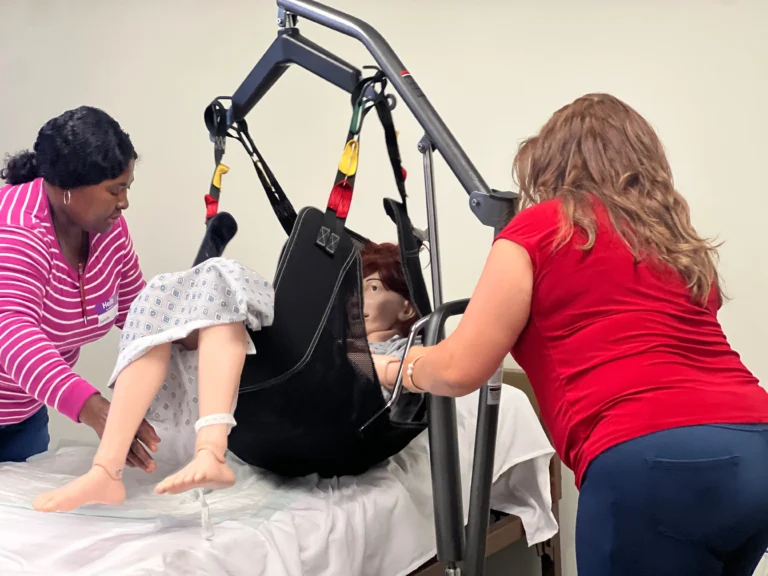Making a Move, Safely: The Importance of Transfer in Quality Care


Making a Move, Safely: The Importance of Transfer in Quality Care
Truly excellent care shows up in the smallest moments. One of those moments is “transfer” – when a caregiver assists a client in moving from one place to another. That might be a move to or from a wheelchair, recliner, shower chair, a dining room chair or other seating.
Experienced caregivers know that transfer is more than just moving a person from Point A to Point B. Each transfer is an opportunity for the caregiver to protect the client’s safety, preserve their dignity, and demonstrate the respect and compassion they deserve, while building the client’s trust and confidence in the caregiver.
Body Mechanics
Performing a transfer safely starts with an understanding of body mechanics – both the caregiver’s and the client’s.
A caregiver must assess the client’s abilities and choose the appropriate method, sometimes using equipment. For clients with limited mobility, a Hoyer lift may be used. This involves placing the client in a sling to transfer them. For clients with limited mobility – but who still have some ability to bear weight — a gait belt may provide extra support in standing or moving between surfaces.
Equally important is the caregiver’s own body mechanics. At Cambridge Caregivers, team members are trained in proper techniques to help prevent injuries while continuing to provide the concierge-level care that our clients deserve and expect. This includes using the legs instead of the back to lift, maintaining a wide stance, tightening the core muscles, and keeping movements smooth and close to the body.
Transferring with Empathy
At a recent orientation session in July, caregiver Shontera sat in a wheelchair as another caregiver prepared to transfer her to an upholstered chair as part of a training exercise.
“I’m nervous,” Shontera said. The experience, she added, made her realize how vulnerable a client might feel during a transfer. As Shontera and her colleagues learned, transfers demand empathy. Being moved by a caregiver can feel frightening or disorienting, especially for clients living with dementia. Caregivers are trained to approach each transfer with calm confidence, reassuring words and clear explanations of what is happening.
“Always tell the client where you will place your hands and what you’re going to do,” said Anthony, who led the training session. This ongoing communication eases fear, builds trust, and preserves dignity.
Practicing for Excellence
At the July orientation, each caregiver paired with a partner to practice transfers. First, they used a gait belt to lift each other from a wheelchair into a chair. Then, they used a Hoyer lift to transfer “Jane,” a training mannequin, from bed to wheelchair.
Trainers Anthony and Margie detailed each step, then observed as caregivers practiced, offering encouragement and specific suggestions.
“Check the Hoyer lift every time before use to ensure it’s working properly,” Anthony reminded the trainees. “Lock the wheelchair and lift before beginning the transfer. Always support the client’s head.”
Experienced caregivers demonstrated how to use the equipment confidently and how to guide the client with calm words:
- “I’m going to transfer you into the chair now.”
- “I’ve got you.”
- “We’re going to take this nice and easy.”
- “How are you doing?”
These seemingly simple steps build trust and reflect Cambridge Caregivers’ commitment to excellence in every aspect of daily living.
Ongoing Training
Transfer skills are taught in detail as part of Manchester Living Institute’s training and orientation. New caregiving staff complete this training when they join the company, and experienced staff typically attend about once a year to refresh their skills. Employees are compensated for their time, reflecting our commitment to their growth, safety and professional development.
Mechanical lifts like Hoyer lifts are powerful tools that reduce strain and increase safety, but they require careful training. Each lift and sling may differ. Selecting and adjusting the sling correctly for each client’s needs and body size is critical to prevent discomfort or injury. Our caregivers are trained to operate all transfer equipment safely and confidently.
If you or a loved one needs assistance with transfers or any aspect of in-home care, Cambridge Caregivers is here to support you with skill, empathy, and a focus on what matters most – your safety and comfort.